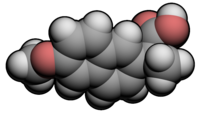Naprosyn
 |
|
 |
|
| Clinical data | |
|---|---|
| Pronunciation | /nəˈprɒksən/ |
| Trade names | Aleve, Naprosyn, Anaprox, Naprelan, Flanax, Aflaxen, others |
| AHFS/Drugs.com | Monograph |
| MedlinePlus | a681029 |
| License data | |
| Pregnancy category |
|
| Routes of administration |
Oral |
| ATC code | |
| Legal status | |
| Legal status |
|
| Pharmacokinetic data | |
| Bioavailability | 95% (oral) |
| Protein binding | 99% |
| Metabolism | Hepatic (to 6-desmethylnaproxen) |
| Biological half-life | 12-17 hours (adults) |
| Excretion | Renal |
| Identifiers | |
|
|
| CAS Number | |
| PubChem CID | |
| DrugBank | |
| ChemSpider | |
| UNII | |
| KEGG | |
| ChEBI | |
| ChEMBL | |
| ECHA InfoCard | 100.040.747 |
| Chemical and physical data | |
| Formula | C14H14O3 |
| Molar mass | 230.259 g/mol |
| 3D model (JSmol) | |
| Melting point | 152–154 °C (306–309 °F) |
|
|
|
|
Naproxen (brand names: Aleve, Naprosyn, and many others) is a nonsteroidal anti-inflammatory drug (NSAID) of the propionic acid class (the same class as ibuprofen) that relieves pain, fever, swelling, and stiffness. It is a nonselective COX inhibitor, usually sold as the sodium salt.
Naproxen poses an intermediate risk of stomach ulcers compared with ibuprofen, which is low-risk, and indometacin, which is high-risk. To reduce stomach ulceration risk, it is often combined with a proton-pump inhibitor (a medication that reduces stomach acid production) during long-term treatment of those with pre-existing stomach ulcers or a history of developing stomach ulcers while on NSAIDs.
Naproxen's medical uses are related to its mechanism of action as an anti-inflammatory compound. Naproxen is used to treat a variety of inflammatory conditions and symptoms that are due to excessive inflammation, such as pain and fever (naproxen has fever-reducing, or antipyretic, properties in addition to its anti-inflammatory activity). Notably, not all medications that reduce fever are anti-inflammatory compounds (such as paracetamol). Inflammatory sources of pain that may respond to naproxen's anti-inflammatory activity are conditions such as migraine, osteoarthritis, kidney stones, rheumatoid arthritis, psoriatic arthritis, gout, ankylosing spondylitis, menstrual cramps, tendinitis and bursitis. It is also used to treat primary dysmenorrhea.
...
Wikipedia
